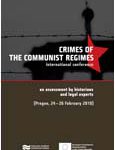Basic information about the losses during the Soviet occupation in 1940–1941 and 1944–1953
Basic information about the losses during the Soviet occupation in 1940–1941 and 1944–1953
Author(s): Emanuelis Zingeris, Rolandas Račinskas
Subject(s): WW II and following years (1940 - 1949), Post-War period (1950 - 1989), History of Communism
Published by: Ústav pro studium totalitních režimů
Summary/Abstract: Most of political prisoners were subjected to “indispensable measures of interrogation” and experienced torture during interrogation. Physical and mental coercion in the system of NKVD and NKGB were concealed under the terms of “physical affect”, “active interrogation” etc. Torture was sanctioned at the highest level. In 1937 the Central Committee of the All-Union Communist Party (Bolshevik) gave the official permit to apply measures of “physical affect”. The largest group of the deportees found themselves in Altai Krai, from where they were moved to the Laptev Sea in 1942. Miserable conditions of life in exile were further aggravated by the climate with the temperatures below 0 °C eleven months per year. Almost all year round (11 months), the sea is frozen. Th is equals to life in the Arctic. Only a little more than 5 per cent of all the exiled there returned to Lithuania 15 or more years later. Th e largest group of the deportees found themselves in Altai Krai, from where they were moved to the Laptev Sea in 1942. Miserable conditions of life in exile were further aggravated by the climate with the temperatures below 0 °C eleven months per year. Almost all year round (11 months), the sea is frozen. This equals to life in the Arctic. Only a little more than 5 per cent of all the exiled there returned to Lithuania 15 or more years later.
- Page Range: 109-111
- Page Count: 3
- Publication Year: 2011
- Language: English
- Content File-PDF

